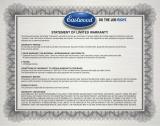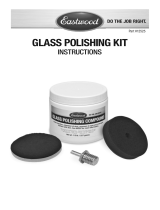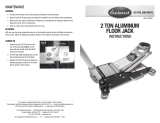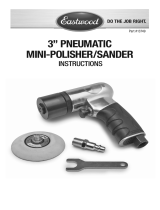Page is loading ...

ELECTROPLATING SYSTEM
INSTRUCTIONS
Part #10049Z
Due to COVID-19, Nitrile Gloves ARE NOT included
in this kit at this time. Nitrile gloves are required
for personal protection while applying this product.

2 Eastwood Technical Assistance: 800.544.5118 >> techelp@eastwood.com
NOTE: Read all safety and operating instructions before use.
The Eastwood Tin-Zinc Plating System contains a mild acid solution. It is entirely safe when
used correctly.
NOT FOR USE BY CHILDREN!
INTRODUCTION
Thank you for purchasing the EASTWOOD HOME ELECTROPLATING SYSTEM. With this system, you
can plate brass, copper, and steel parts (not for stainless steel, aluminum, chrome, or pot metal). This
product works on the same principles as a commercial plating system, and with a little experience and
practice, you can achieve the same results. We have spent an extensive amount of research time in
order to deliver a system that is safe, easy to use, and dependable.
NOTE: This single-step plating system is not recommended for larger parts that require the additional
corrosion and abrasion resistance that only triple chrome plating can provide.
CAUTION: All safety precautions mentioned in these instructions should be followed at all times.
CONTENTS
Your electroplating kit contains the following items:
• 1 battery box with leads
• 1 two quart container of electrolyte
• 1 pair of safety goggles
• 1 tube of Autosol polish
• 1 funnel
• 1 pair of disposable gloves
• 1 electroplating touch-up brush
• 1 anode bar
• 1 process bottle
You will need to supply 2 D size batteries (not included).
If anything from the above list is not included in your kit, please call:
Eastwood Customer Services Department at 1-800-544-5118
IMPORTANT SAFETY INSTRUCTIONS
READ ENTIRE MANUAL BEFORE USE!
The electroplating solution, known as “electrolyte,” contains sulfuric acid. Extreme care should be
taken that the liquid does not come in contact with skin or clothing. If spilled on clothing, remove and
rinse with cold water. If splashed into eyes, rinse with large amounts of water and call a physician. If
swallowed, do not induce vomiting and call a physician.
• Safety goggles and gloves are included with your electroplating kit.
They must be worn at all times while plating.
• Keep electrolyte (plating solution) out of reach of children and pets.
• DO NOT store solution in any type of metal container since the electrolyte chemically
interacts with certain metals.
• Keep electroplating solution stored at 40° to 95° F and only in its original plastic bottle with the
lid sealed tight when not in use! Transfer to and from the wide mouth process bottle using the
supplied funnel.
• DO NOT store solution in the wide mouth process bottle.
• DO NOT allow solution to contact any household chemicals or cleaning materials.
A reaction may occur either releasing dangerous gasses or rendering the plating solution
worthless.
• ALWAYS set up your plating system in an area close to a cold water source and work in
a well ventilated area.
If running water is not available, several buckets of fresh water will do.
• DO NOT smoke while plating.
• DO NOT eat or drink while plating.
• DO NOT operate the plating system while under the infl uence of drugs or alcohol.
For spills, leaks, fi re, or exposure call Day or Night:
Chemtrec 1-800-424-9300 (USA – Toll Free) 202-483-7616 (International – Collect)
*MSDS Sheet available upon request.
To order parts and supplies: 800.345.1178 >> eastwood.com 3
Due to COVID-19, Nitrile Gloves ARE NOT included
in this kit at this time. Nitrile gloves are required
for personal protection while applying this product.
Due to COVID-19, Nitrile Gloves ARE NOT included
in this kit at this time. Nitrile gloves are required
for personal protection while applying this product.

4 Eastwood Technical Assistance: 800.544.5118 >> techelp@eastwood.com To order parts and supplies: 800.345.1178 >> eastwood.com 5
PREPARING PARTS FOR PLATING
As with any restoration or decorative process, the fi nished product is only going to be as good as
the preparation. The actual electroplating process is only the fi nal step. Any fl aws found in the part
before plating are still going to be there after the plating, unless you prepare properly.
If you want the fi nished piece to have a mirror-like shine, polishing and buffi ng the part before
plating will be necessary.
1. DISASSEMBLE OBJECT TO BE PLATED
First, any object to be plated should be disassembled into individual pieces. Nothing should be
left bolted together if possible.
2. REMOVE ALL GREASE, OIL, PAINT, OR RUST
All parts should be free of grease, oil, paint, or rust. Old paint may be removed by abrasive
blasting, paint remover, or sanding. Eastwood carries many products which can aid in this
process. To ensure that the parts are chemically clean, we recommend that they be soaked in
Eastwood’s Fast Etch Rust Remover and then rinsed before plating.
3. CLEAN WITH A MILD DETERGENT
After surface preparation, all parts should be cleaned with a mild detergent, followed by a wax
and grease remover. We recommend Eastwood’s PRE Painting Prep (#10041Z).
4. CLEAN IT AGAIN!
There is a general rule that should be followed for any kind of plating preparation: when you
think the part is clean enough to be plated, clean it again! For best results and enhanced corro-
sion protection, use Eastwood’s Fast Etch (#19416Z pint or #19418Z gallon). Allow Eastwood’s
Fast Etch to chemically clean the part for about 10 minutes or longer, as needed to assure all
rust is removed. Rinse in clean running water and immediately (do not let the part dry) place it
in the plating bath.
5. HANDLE CLEANED PARTS WITH GLOVES
It is very important that you do not handle the cleaned pieces with your bare hands. You may
leave traces of oil on the part which will cause problems. Cleaned parts should be handled with
gloves or pliers, being careful not to scratch them.
6. PLATE THE PREPARED PARTS RIGHT AWAY
Parts that are cleaned are subject to corrosion quite rapidly; this is called “fl ash rusting”. For
this reason, it is very important that the parts be plated as soon as possible after preparation.
SETTING UP THE SYSTEM
NOTE: For safety purposes, we recommend that you set up your plating system as close as possible
to a water source. Eastwood does not recommend that you use your kitchen counter due to the prox-
imity of food, and that the electrolyte may discolor some decorative counter tops. If a running water
source is not available, several buckets of fresh rinse water will be suffi cient.
Shake the Solution in Original Container
Due to the nature of the electrolyte, some settling of chemicals may occur. Check to make sure the
lid is secure, then shake the solution to ensure a uniform mixture of the contents. Some sediment is
normal and will not affect performance.
Put Container on a Level Surface and
Hook Anode Bar Over the Rim
After shaking the solution, pour it into a wide mouth
plating container then place it on a level surface.
Take the anode bar and hook it over the rim (mouth)
of the container allowing it to hang into the plating
solution.
Attach the Wire to The Anode
Attach the small silver alligator clip on the red
(positive) wire to the end of the anode bar which is
hanging over the end of the solution container. It is
very important that you do not allow this clip to enter
into the plating solution as this may contaminate it.
The black (negative) wire attaches to the part you
will be plating. Note: Be sure positive battery post is
touching battery holder contact.

6 Eastwood Technical Assistance: 800.544.5118 >> techelp@eastwood.com
HOW IT WORKS
Attach Clip to The Part
After properly cleaning the part, attach the copper clip
on the end of the black wire to the part to be plated.
Try to attach the clip as close as possible to the edge
of the piece, or to a section that will not be visible
when the part is reassembled. Also, a length of copper
wire can be used to connect the part to the clip if
needed.
Place The Part in the Solution
Place the part into the solution making sure that it
does not contact the anode on the way down. If the
part touches the anode during plating, a discoloration
may form at the point of contact. Make sure the part is
fully submerged. Any portion of the piece that remains
above the surface of the fl uid will not plate. It is ac-
ceptable to submerge the copper clip into the solution
but better to use a copper extension wire. It will be
plated along with the part.
Plating Time and Thickness
The thickness of the plating depends on the amount of
time the part is left in the solution. There are no “fi xed
times” for leaving parts in the plating bath; experience
and practice will guide you. Try to fi nd some scrap
pieces to practice on before doing “the good stuff”. Larger objects take longer than smaller objects,
with the maximum being about thirty minutes. To give you a rough guide, the average bolt takes about
three to four minutes for suffi cient plating build-up. Over-plating can happen and should be avoided.
You will know if you have over-plated the part if it comes out of the bath with a rough, crusty surface.
If this happens, you will have to remove the plating and start over. Plating can be slowly removed by
reversing the polarity at the battery.
To order parts and supplies: 800.345.1178 >> eastwood.com 7
FINAL FINISHING OF PLATED PARTS
Check the part about every three to four minutes. The gray fi lm that forms on the surface of the anode
is normal. Plating effi ciency decreases as the gray fi lm builds on the anode. Take the anode out of
the bath after about every fi fth part that has been plated and clean it by brushing gently with a nylon
brush (a clean toothbrush works great) under clean running water. Note: For extended anode life, re-
position the anode so that a different area of the bar is in contact with the electrolyte. When you have
completed plating the part, remove it from the solution and rinse it for about sixty seconds in fresh
water. The part is now ready for fi nal fi nishing.
Final Finishing
Your part is now electroplated with real metal tin which
will resist corrosion and rusting with minimal care.
The gray fi lm which forms over the part while plating
can be removed easily by hand, using the Autosol pol-
ish included in your kit. Machine buffi ng of the fi nished
piece is not necessary nor is it recommended.
Parts which are pitted on the surface can be fi nished with an attrac-
tive satin sheen by lightly glass beading them or by using a fi ne scuff
pad. For best long-term durability, degrease with PRE or Acetone and
coat with Diamond Clear Gloss for Bare Metal (#10200Z) or Extreme
Diamond Clear (#29894Z).
With a little imagination, you can see the many uses for your elec-
troplating system. It can be used for cars, boats, antiques, jewelry or
virtually anything made of metal. The alloy which is deposited on the
surface is non-toxic and lead-free, so it is environmentally safe.
Pieces treated with the electroplating system have an excellent cor-
rosion resistant base which can be easily painted over without such
compatibility problems as lifting or bleed-through.
The system is not recommended for use over chrome plated parts or
for large parts such as bumpers or wheels.

© Copyright 2011 Easthill Group, Inc. Instruction part #10049ZQ Rev. 6 /11
STORING THE ELECTROPLATING SYSTEM
Storage of the Electroplating System
When not in use, remove the anode bar from the solution, clean it with a nylon brush under running
water. Pour the plating solution back in the storage bottle using the included funnel. Be sure the
container’s plastic lid is tightened securely. Rinse the plating container in clean running water. Store
the solution at temperatures between 40° to 95° F and out of reach of children and pets. Remove the
batteries from the holder. Rinse off the black lead with clean water thoroughly to ensure that all traces
of the electrolyte have been removed. (Traces of the solution left on the clip will affect its performance
if left on for extended periods). Store the wire leads and batteries in a dry place.
Connecting The Electroplating Touch-up Brush
1. Attach the small alligator clip on the red wire to the brush.
2. Attach the large copper clip on the black wire the to part to be plated.
Using The Electroplating Touch-up Brush
NOTE: There are no fi xed times for plating. Experience and practice will guide you. Do not stroke
the brush as if to paint the surface.
1. Dip the brush head into the electroplating solution. Be careful to wet only the bristles.
2. Hold brush with bristles against surface to be plated. Avoid surface contact with the metal
parts of the brush. Brush the part very slowly (in one direction) for about 10 seconds.
3. Repeat as necessary until plating is the desired thickness.
Replacement Components
Your electroplating kit can plate literally dozens of parts effectively. After some time, however,
the components may need to be refreshed.
Electrolyte Replacement
Replaces the electrolyte solution that may get contaminated during normal plating system use.
2 quart container (#10049ZB).
Anode Replacement
Replaces eroded anodes that result from normal usage of the plating system.
Pack of 2 anodes (#10049A).
If you have any questions about the use of this product, please contact
The Eastwood Technical Assistance Service Department:
800.544.5118 >> email: techelp@eastwood.com
The Eastwood Company 263 Shoemaker Road, Pottstown, PA 19464, USA
US and Canada: 800.345.1178 outside US: 610.718.8335
Fax: 610.323.6268 eastwood.com
/















